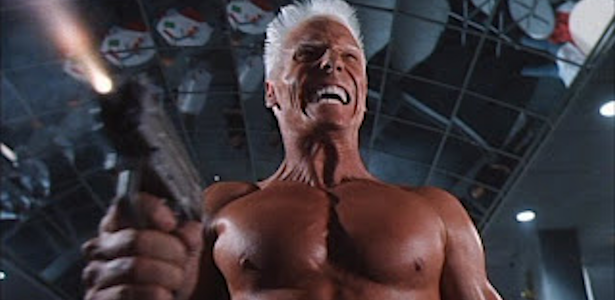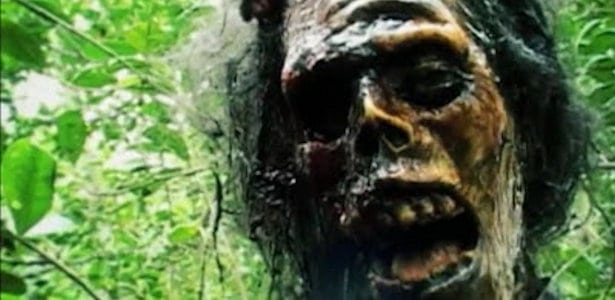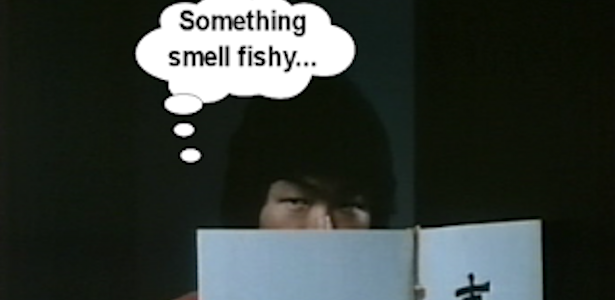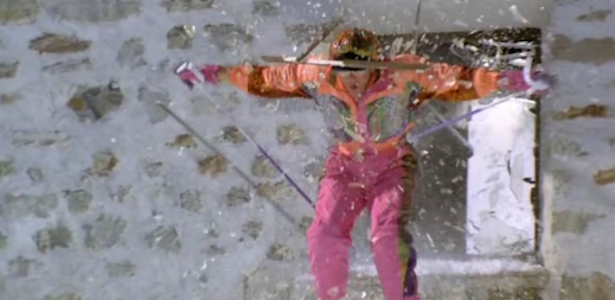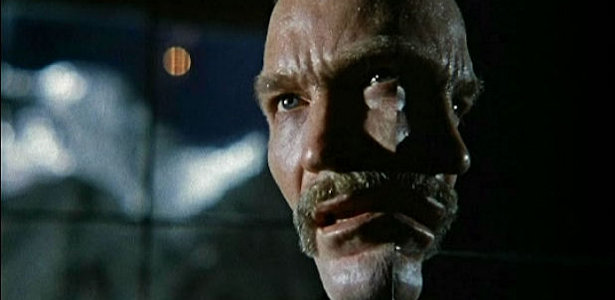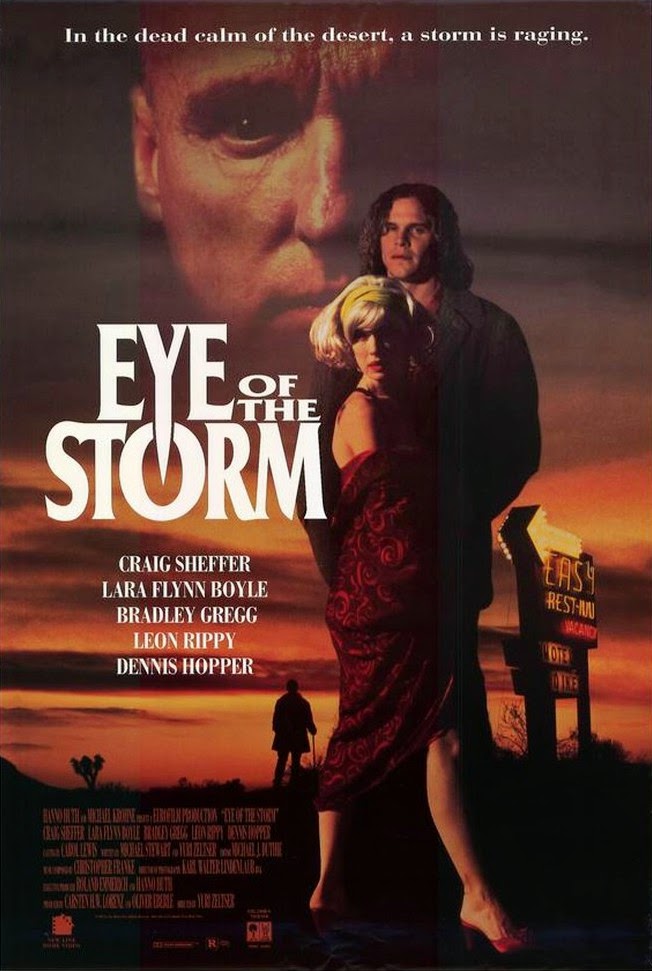“I heard a man on TV one time say that paranoia is just another word for heightened awareness.” – Old Man (Charles Tyner)
Hollywood is rife with horror stories regarding the struggles of first time filmmakers. We’ve heard of neophytes being skipped over, frozen out, and physically removed from their pet projects. But would you believe me if I told you the account of a first time filmmaker who managed to direct his own script free of struggle, impress his bosses and the studio still managed to screw it up? Such is case with PULSE (1988), a science fiction thriller written and directed by Paul Golding.
Growing up, I was familiar with PULSE due to the eye catching VHS cover. Oddly, I never saw it as a kid and only caught up with the film this year. Telling the story of a young boy (Joey Lawrence) who must fight a seemingly evil electrical current in his father’s California home, PULSE took me by surprise and shocked me. It was an incredible well made science fiction film that was as scary as it was intelligent. Not only that, but it worked as an impressive allegory of man succumbing to technology, a sentiment that is even more relevant today. Emerging in a decade fondly remembered for its sci-fi masterpieces, this was no easy feat. Surprisingly, there was very little info on both the film and Golding online. Hoping to correct this, I contacted Mr. Golding and expressed interest in the history of PULSE. Thankfully, the genial Golding was more than happy to discuss his lone feature film.
In order to trace the pathway to PULSE, we have to go all the way across the country. A native of Troy, New York, Golding grew up with a love for science fiction and the desire to become a theoretical physicist. He would express his creativity as a kid by recording reel-to-reel comedy tapes with friends and this eventually led to an interest in filmmaking. “One of my friends suggested we get a camera and film this weird stuff that we were laying out on audio,” he explains. “So I got my mother to get me an 8mm camera. I started shooting stuff and it was weird stuff. I’ve always loved movies, but to me movies were always Grace Kelly and Jimmy Stewart. What I was doing was like ‘The Waste Land’ by T.S. Eliot on 8mm set to a piece of music.”

It was a confluence of three disparate things that eventually sent Golding on his path to being a filmmaker – the launch of Sputnik, the experimental film QUEEN OF SHEBA MEETS THE ATOM MAN (1963), and an article on film schools in the New York Herald Tribune. The Russians’ space success made him realize that the United States only wanted hands on workers rather than theoretical ones in the Space Race. With that out of the way, he was again drawn to film. “I went down to Cooper Union and they screened Ron Rice’s QUEEN OF SHEBA MEETS THE ATOM MAN,” Golding reveals. “And I realized, ‘Holy crap, I’m an underground filmmaker’ and knowing I had some place in the universe was really quite helpful. And then I read an article in the Herald Tribune that said there were schools that actually taught filmmaking. They said there were only two schools, there were actually three. They only mentioned in the article USC and UCLA. If they had mentioned NYU, I would have gone there and my life would have been completely different.”

Golding eventually ended up at USC’s historic cinema department and he soon found himself among some soon-to-be-historic classmates including John Milius, Basil Poledouris, Walter Murch, and a gentleman by the name of George Lucas. Golding was fascinated by Lucas’ early short LOOK AT LIFE (1965), which incorporated a technique using still photographs by animation teacher Herb Kosower. Golding made his own attempt at this technique with the short WIPEOUT. Golding and Lucas soon found themselves in the same film aesthetics class instructed by Woody Omens, who had the students work in groups of two. “So George and I paired up,” he says. “Since I was in charge of the stockroom, I was able to get us the Arriflex because we only had one. We went down to Figueroa and the first thing we saw were these reflections on these highly polished chrome parts of this Volkswagen. So we shot 100 feet of film on that; we took turns finding shots and then taking them. And when we showed it the next week, everybody went crazy. So Woody said why don’t I give you another 100 feet of film and you can make a movie. So we went back to Figueroa. The Volkswagen wasn’t there, but another car was. I edited it to a piece of music from a Miles Davis album that Herbie Hancock was a piano soloist on.” The resulting experimental film was the three minute short HERBIE (1966) and it highlighted Golding’s mastery of editing. This talent proved beneficial after school when he worked as an editor on Haskell Wexler’s MEDIUM COOL (1969).
After briefly relocating to San Francisco, Golding returned to Los Angeles to get into the film industry. He met Zalman King in the early 1970s and the duo struck up a creative partnership when King asked Golding to rewrite his screenplay, BAKERSFIELD BLUES. The resulting script was titled POWER and revolved around carnival worker running a machine that was literally the thing of nightmares. “The Dream Machine was this visual thing,” he explains, “a way of terrifying people, making them believe something was happening.” The script was optioned by RSO (Robert Stigwood Organization) in 1975. Although it attracted several high profile directors including Michael Apted and Bob Rafelson, the project never got made. In fact, the highly prolific Golding/King collaboration saw several screenplays developed – SWAGGER at 20th Century Fox and GODSHEAD at Mutual Pictures – but none ever found their way before the cameras.

Instead, Golding found his first feature writing credit come via the small screen, although it wasn’t intended that way. Along with co-writer David Irving, he wrote a screenplay about a young boy who encounters a little Bigfoot while lost in the woods. Appropriately, it was called LITTLEFOOT. After several producers told them it would be a perfect film for Disney, the two writers took it to the Home of the Mouse. The enthusiasm for the project went quickly up the chain of command until Ron Miller – president of Walt Disney Productions in addition to being Disney’s son-in-law – offered a truly bizarre alteration. “He said, ‘It’s a sweet little story and would make a great film, but the Disney organization is not going to subscribe to the Bigfoot myth,’” Golding relays. “In one of the best turnarounds I’ve ever pulled off in an actual meeting, I said, ‘What if it wasn’t Bigfoot, but the last Indian of a tribe?’”
It was a move that could surely earn Golding the Indian sobriquet of “Quick on his Feet” as it worked. The revised project was soon given the green light and shot under the title of THE SECRET OF LOST VALLEY under the directorial eye of actor Vic Morrow. It debuted in two parts on WALT DISNEY’S WONDERFUL WORLD OF DISNEY in April and May 1980. While Golding was not satisfied with the final product, he did earn a Writer’s Guild award for the script as the Guild judged nominated screenplays based solely on the writing and not the film itself. The experience would also steel him for dealing with executives who might want to change his PULSE script.


It was during this productive period in the ‘70s that Golding also started writing what would eventually become PULSE. Copyrighted under various names including CURRENTS, HOUSE, and TRACT, the story’s genesis began with an innocuous comment by one of Golding’s friends. “I was living in a house in Eagle Rock, which is next to Glendale, California,” Golding explains, “basically a tract house. After I had just gotten divorced, I got a number of friends in from USC to come share the house with me so I wouldn’t be lonely. One of them was Caleb Deschanel, who is one of the best cinematographers ever. I remember one morning at breakfast he came in and said, ‘You know, it’s so weird. Last night I was just listening to the little sounds the house makes – the furnace turning on and off and the flexing of the pipes – it was like the house was alive and it was taking care of me.’ He wasn’t used to central heating. That idea kind of stuck with me for a while and I started thinking about the dark side of the house taking care of you and it kind of grew out of that.”
Helping expand that seed of an idea was the story another friend told Golding about a computer he built for the telephone company that eventually reprogrammed itself to avoid the very problem it was built to detect. Those ideas combined with Golding’s desire to tell a tale about our increasing dependence on technology resulted in the story of a married couple trapped in a house by an evil current. “The film did evolve,” he says of his script. “It wasn’t until the later stages that I solved the ultimate problem in the film. The ultimate problem in any ‘haunted house’ film is why they just don’t get out. To hell with the mortgage, you’re going to die if you stay. The solution to that was making the main character a kid because he simply just couldn’t get out. That solved my problem and the last couple of drafts were with the boy as the main character in it.”
One of the screenplay’s best (and most admirable) elements is that Golding refuses to explain just what exactly the evil electricity is. It just appears in the grid after a lightning bolt hits a power station. We don’t know if the current is of alien origin, man-made or even a ghost in electrical form. Naturally, such ambiguity is frowned upon by movie executives. When asked if he was told to change his script to explain it more, Golding replies, “Endlessly. They always wanted to know more. Take a film like POLTERGEIST (1982), which I really enjoyed up until the end. It is very well made and a very good story. I hated that there was this burial ground explanation. Whenever you see the monster, it is always a letdown.”
The ominous lightning bolt in the opening of PULSE:
Regardless of the ambiguity, the script drew immediate interest. “I really don’t know what the actual number is,” he states, “but I’ve been telling people that I sold it nine times. Maybe it was eight or it was ten. I sold options on it basically. I sold a first look on it before I wrote it to some people.” Golding even once sold the script outright as a TV movie, a move that thankfully never panned out.
By the time the 1980s rolled around, Golding reasserted the idea of getting PULSE off the ground. A kink emerged early on when POLTERGEIST opened and several people deemed PULSE as too similar. Golding had also worked with friends Andrew Davis and David Gilbert on writing the hip-hop film BEAT STREET (1984). It was seeing Davis, who was the film’s original director, fired that steeled his trepidation of directing his own script. “I sat with him at the bar that night after he had been fired and I saw the pain,” he discloses. “I thought to myself afterward, ‘Well, that is about as bad as it gets and he’s alive.’ So I thought I can’t do any less and that kind of stiffened me.”

Golding had support from his friend and manager William McEuen, who eventually set PULSE up under his Aspen Film Society company with Columbia lined up as distributor. Columbia was in a period of transition in 1986/87 as parent company Coca-Cola (yes, they were owned by the soda manufacturer) sold off Embassy Pictures, Embassy Home Entertainment and The Walter Reade Organization. British film producer David Puttnam and David Picker were installed as Columbia’s CEO/Chairman and President, respectively. Known for producing less Hollywood and more dramatic fare, the Two Davids added PULSE to their schedule with a budget of $6 million dollars. In addition to being given a healthy budget, Golding was also allowed to pick his own producer and selected Patricia Stallone for the job.
Golding set out to cast the film and a number of familiar faces including Tommy Lee Jones auditioned for the role of the father, Bill. Golding relays an amusing anecdote with regards to one casting session. “Our casting agents had done ST. ELSEWHERE,” he explains, “so we got a number of people through them for various parts. And one of them was David Morse. It was amazing. He did a scene and after he left we all looked at each other and were like, ‘Wow, he’s it. That’s fantastic.’ He killed it. There was a power in that room that came from him and that was just awesome. And then we looked at the tape and [the great performance] wasn’t there. It was the strangest thing I’d ever encountered.”

Thankfully, casting the film’s main character was much easier. In a town known for terrible tykes, Golding was fortunate to land 11-year-old Joey Lawrence as his lead. Already a showbiz veteran with 77 episodes of GIMME A BREAK under his belt, Lawrence came in and immediately wowed the filmmakers. “Joey was pretty much automatic,” Golding reveals. “His parents walked in with him and it was, ‘Okay, he can do it.’ He’s got the experience, the look and he is the right age. I don’t think we interviewed maybe one other person before we decided he’s it.”
The acquisition of Lawrence also proved to be a bit of a package deal as his younger brother Matthew also snagged the role of friendly neighbor Stevie. “When Joey’s parents came in, they said, ‘We also have Matty here.’ Matty couldn’t read [but] had memorized that whole long speech that he does on the curbside with Joey and he just knocked it out of the ballpark.”

Filming began in May 1987 in California with a bulk of the exteriors taking place in a four house cul-de-sac. The great W.C. Fields once opined that a filmmaker should never work with animals or children, but Golding had very few problems with Lawrence. “The biggest problem I had with Joey was the TV thing,” he says. “TV acting and movie acting are very different. TV acting is a small screen and you’ve got to put a lot into it to come across; in movies it is a very big screen and you need to be a lot more subtle. There was the scene where Joey has his experience with Charles Tyner and he is totally upset. When we did the first look at that scene, Joey was television. He was waving his arms. I said, ‘Okay, look, you’ve got to tone it down. You’ve got to keep the same intensity but you can’t do the thing with your hands, okay?’ So he did it again and they kept sneaking out. So I said, “Okay, sit on your hands literally.” Instead of doing the wide shot first, we did his close up first and he literally had to sit on his hands. If they started to move out from underneath his legs, I’d say cut and we’d do it again.”


Editing ran concurrent to shooting and, despite his background as an editor, Golding put full trust in his cutter, Gib Jaffe. Fans of the film will be interested to know that the original cut ran 2 hours and several scenes found their way onto the cutting room floor. “There is a scene,” he divulges, “that was alluded to where Joey says, ‘Yeah, [Ellen] took me riding.’ That was a scene up in the hills with these big electric transmission lines and she tells the story of when she was a little girl and they put these power lines in and then these tract houses happened after that and she somehow thought that there were signals that caused that to happen. It adds to his thought process. It just wasn’t a good enough scene and we decided the film moved better without it. That was the most important [cut]. We also had some scenes that we shot in Colorado of him with his mother before he comes. We just see suitcases in the hallway and him playing with other kids. At that point early in the film we just felt it was going on too long.”
When film wrapped, Golding had come in one day early on principal photography and one million dollars under budget. While most would consider this a feat to be lauded, Golding found out that in Hollywood it wasn’t considered desirable. “I was informed by someone who knew these things that that was not good,” he says. “I thought it was great! We made the film and I got everything I wanted and it is a million dollars less. But they said when the studio sees you’ve come in a million dollars under budget they’re going to feel cheated. They know that that script ought to cost six million dollars and if you only spent five, you must have cheated them somehow. So we found ways to spend the other million dollars. I understood what they were saying, it made insane sense.”
Various PULSE video boxes (click to enlarge):
Golding eventually used this money to secure what is perhaps one of the film’s best technical features, Macro photography. While they did discuss the effects with his pal Lucas’ ILM (Industrial Light and Magic) studio, Golding eventually went with a more unconventional choice. “The people from Oxford Scientific Films came to us when we were looking for people to do it and they had a wonderful reel of material. They had designed this rig over in England that could do extraordinary close up, macro photography. They definitely wanted to bring their equipment over to Hollywood and get it done here, but that was at the point in time when we really needed to add money to the budget, so I said, ‘No, we’ll all come over there.’ It was all done at their studio at Oxfordshire.
“They are all extreme, extreme close ups. We didn’t build any models to photograph. We used real microcircuit and regular circuits. The only trickery we did is in the scene inside the television set where the electronic pathways are reconfiguring themselves. That was photographed and then played backwards.”
Several examples of the Macro-photography,
creating an almost alien-like landscape:
With the film completed in the fall of 1987, Golding screened the final product for friends and Columbia executives. The reaction proved far beyond anything Golding could have anticipated. “David Picker, the President of Columbia the time, was sitting a couple of seats over,” he reveals. “At the end of the film David came up to me and said, ‘Feel my hands.’ It was the weirdest thing anyone had ever said to me. He said, ‘Feel my hands, my palms are sweating.’ He said, ‘I love this film, this is a great film. We’re going to do this and that. We’re going to do a 70 mm blowup. We’ll release it separately in New York and L.A. to get word of mouth [going] and this will be our big film this summer.’”

Unfortunately, this excitement was short lived. In late September 1987, Putnam and Picker were removed from their posts at Columbia. Former Paramount executive Dawn Steel was announced as the incoming President on October 28, 1987 and this essentially gave PULSE a flat line. Rather than judge a film solely by its own merit, Steel adopted the Hollywood mindset of “I can’t support what my predecessor produced” and dumped an entire slate of releases between January and March 1988. Of all the pictures (including Spike Lee’s SCHOOL DAZE, Richard Benjamin’s LITTLE NIKITA, and Terry Gilliam’s THE ADVENTURES OF BARON MUNCHAUSEN, which would sit on the shelf an additional year), PULSE received the roughest treatment as it was given a limited two market opening in Oklahoma and Texas on March 4, 1988. Golding had gone from the perfect situation – directing his own script with zero studio interference and support from the highest executives – to a frustrating nightmare of studio politics. “Until the dream got popped by Dawn Steel, it was a dream scenario,” he laments.
Columbia's early 1988 release schedule
(notice the number of February & March dates):
The unceremonious dumping of PULSE obviously bothered the filmmakers. So much so that a lead article in Variety on March 8, 1988 appeared under the title “PULSE Makers Charge Columbia Is Dumping Film.” It was doubly disappointing as the film received excellent reviews from The Houston Post and Variety. Golding, however, had little time to mourn as he was soon onto his next project, co-writing and directing a film adaptation of BREAKFAST OF CHAMPIONS. “At that point, I had been on a new journey of discovery with Kurt Vonnegut,” he details of his time post-PULSE release. “He had been my hero forever, so the idea of working on a Vonnegut novel as a film was very cool and it kind of put behind me what had just happened.”

The project was set up at Handmade Films and the company even went so far as to announce a specific shooting start date (June 19, 1989) in Variety. “They had a budget of $7 million dollars and I had gone over it with their production person,” he reveals, “I had gone through to do the board and overall budget. We agreed that as long as the above the line [talent] didn’t get out of hand that the film could be made from the script that Peter Bergman and I have written.” Golding’s ideal scenario would have seen Robin Williams as Dwayne Hoover and Gene Hackman as Kilgore Trout. Unfortunately, the film never made it before the cameras. While declining to offer specifics, Golding does mention it was an honor to work with one of his heroes and says Vonnegut was pleased with their script, which made several huge alterations to the source novel, changes that the author admired (more on that can be read on Golding’s website
here).
Golding continued to write with the screenplay EUDAEMONIC PIE (“a bunch of brilliant young scientists who go off to take on Las Vegas with a computer in the sole of their shoes” he says of the plot). Soon, however, he found himself like a character in PULSE and at the mercy of modern technology. “My wife and I ended up taking the advice of her son,” he explains of his post-Hollywood work, “and opening a store because she had a business background.”
Together they opened an internet store right as it was taking off and ended up literally catching a “wave” at the right place at the right time. “We sold a little of this and a little of that,” he says. “Then we put a product called the Leatherman Wave on there. Leatherman didn’t have very good distribution, but it had an enormous reputation; when we put that online, we literally started receiving orders faster than we could print them. We got a faster printer.”

Golding relocated to New York in the new millennium and he and his wife restored a farm house they bought together. Although it would appear his filmmaking years are behind him, Golding had a surprising answer when asked if he ever thought of doing a sequel or remake to PULSE. “I wrote a screenplay right after PULSE,” he reveals, “a film that I never sold. [It’s] a detective story that, in a sense, is almost a sequel. Right now we’re all trying to get together and figure out how to get it made. Originally it was called AAMES, but right now it is recently re-titled MACROCHIP. It is certainly not the same characters. It has the same kind of thematic content of this thing that’s bigger [than the characters] and in this case is almost, but not quite, explained.” He is currently developing it with local filmmaker Jon Cring and it will allow Golding to work with his son Nick, who is also a film editor.
Twenty six years after PULSE’s inauspicious release, it is a testament to the film and Golding’s filmmaking skills that people are still talking about the film. Golding has even screened it twice in Schenectady to appreciative audiences. “It is nice that other people have seen it. It is nice that people say good things about it to me,” he says.
As for his own thoughts on the film, Golding is modest in his assessment. “I thought it was pretty good,” he says. “I’d give it a B+.”
 Saint-Clair, bent for revenge (in an extremely Colgate ad kind of way) is hot on the heels of Karpov (Vittorio Caprioli), a megalomaniacal arch-villain with an army of black leather clad troopers who is looking to take over the world with his organization of evil. Actually, Saint-Clair spends less time chasing after Karpov than he does chasing after the ravishing Tatiana (Jacqueline Bisset), and who can blame him? Karpov is actually the one doing the chasing, desperately trying to liquidate Saint-Clair by any means necessary. Those means usually are sending hordes of his foot-soldiers after Saint-Clair only to be casually shot down by the super-agent in mid-tryst. And this is only the beginning of the film!
Saint-Clair, bent for revenge (in an extremely Colgate ad kind of way) is hot on the heels of Karpov (Vittorio Caprioli), a megalomaniacal arch-villain with an army of black leather clad troopers who is looking to take over the world with his organization of evil. Actually, Saint-Clair spends less time chasing after Karpov than he does chasing after the ravishing Tatiana (Jacqueline Bisset), and who can blame him? Karpov is actually the one doing the chasing, desperately trying to liquidate Saint-Clair by any means necessary. Those means usually are sending hordes of his foot-soldiers after Saint-Clair only to be casually shot down by the super-agent in mid-tryst. And this is only the beginning of the film! Saint-Clair, bent for revenge (in an extremely Colgate ad kind of way) is hot on the heels of Karpov (Vittorio Caprioli), a megalomaniacal arch-villain with an army of black leather clad troopers who is looking to take over the world with his organization of evil. Actually, Saint-Clair spends less time chasing after Karpov than he does chasing after the ravishing Tatiana (Jacqueline Bisset), and who can blame him? Karpov is actually the one doing the chasing, desperately trying to liquidate Saint-Clair by any means necessary. Those means usually are sending hordes of his foot-soldiers after Saint-Clair only to be casually shot down by the super-agent in mid-tryst. And this is only the beginning of the film!
Saint-Clair, bent for revenge (in an extremely Colgate ad kind of way) is hot on the heels of Karpov (Vittorio Caprioli), a megalomaniacal arch-villain with an army of black leather clad troopers who is looking to take over the world with his organization of evil. Actually, Saint-Clair spends less time chasing after Karpov than he does chasing after the ravishing Tatiana (Jacqueline Bisset), and who can blame him? Karpov is actually the one doing the chasing, desperately trying to liquidate Saint-Clair by any means necessary. Those means usually are sending hordes of his foot-soldiers after Saint-Clair only to be casually shot down by the super-agent in mid-tryst. And this is only the beginning of the film! This completely over-the-top, occasionally surreal spoof of James Bond films works amazingly well. It is hugely imaginative, incredibly bloody (in a cartoon way) and often hilarious. Better still, (big spoiler) it has another layer. We discover that Bob Saint-Clair is actually a work of fiction, a character written in a series of novels by the scruffy, chain-smoking writer François Merlin (Belmondo, again). Merlin uses the people he sees in everyday life as characters in his novels including his sleazy, egotistical boss (Caprioli) and the lovely, book-worm college student (Bisset) down the hall.
This completely over-the-top, occasionally surreal spoof of James Bond films works amazingly well. It is hugely imaginative, incredibly bloody (in a cartoon way) and often hilarious. Better still, (big spoiler) it has another layer. We discover that Bob Saint-Clair is actually a work of fiction, a character written in a series of novels by the scruffy, chain-smoking writer François Merlin (Belmondo, again). Merlin uses the people he sees in everyday life as characters in his novels including his sleazy, egotistical boss (Caprioli) and the lovely, book-worm college student (Bisset) down the hall.



